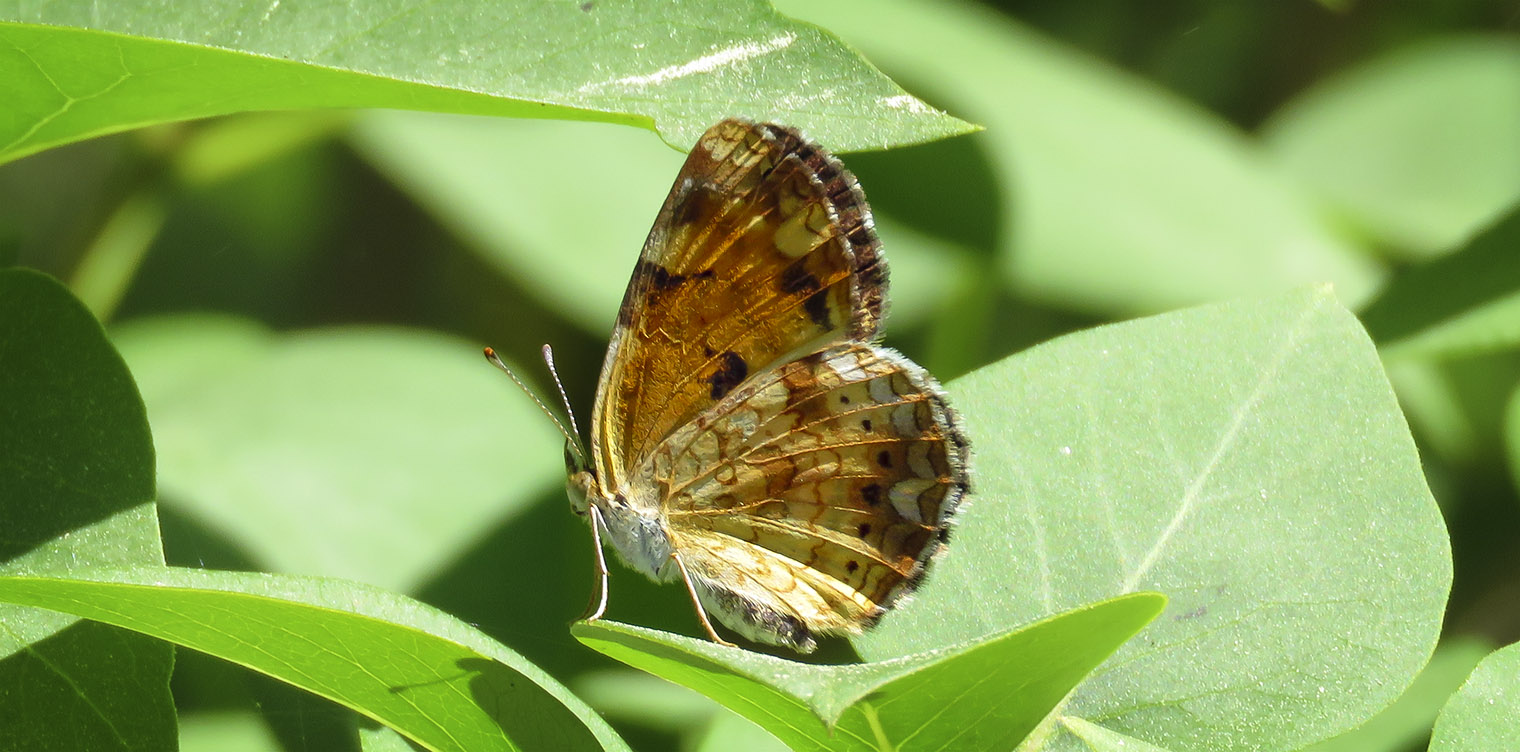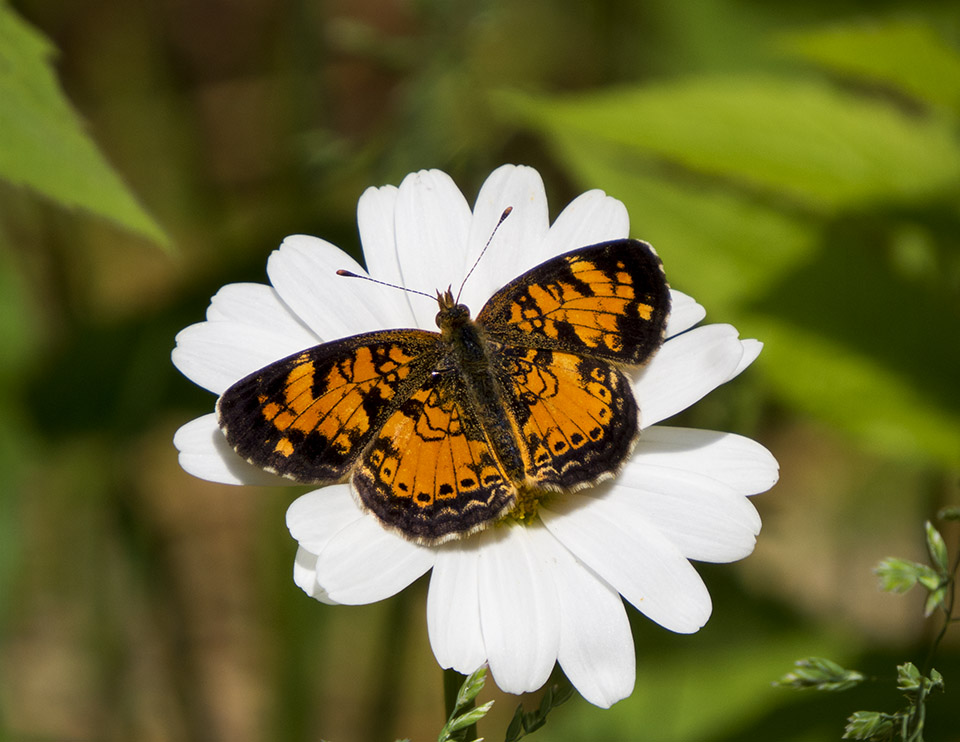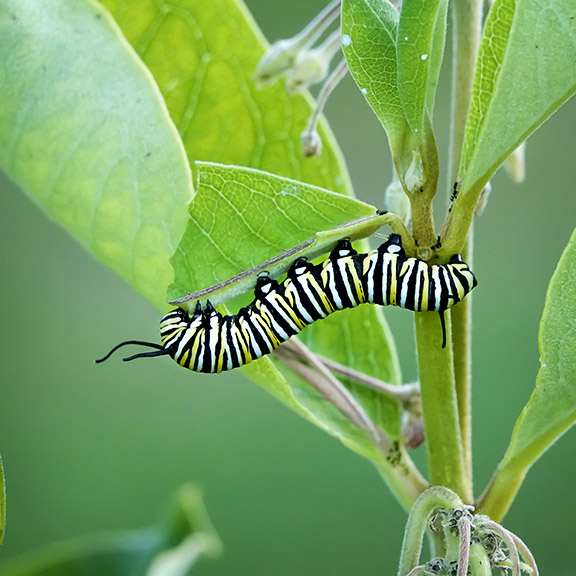Butterflies of the Adirondacks:
Northern Crescent (Phyciodes cocyta)

The Northern Crescent (Phyciodes cocyta) is a small orange and black butterfly that may be seen in the Adirondack Mountains of upstate New York in summer. It is a member of the Brushfoot family. [1]
Its nonscientific name derives from the crescent-shaped spot near the margin of the hind wing below. [2] It is sometimes referred to as the Northern Pearl Crescent. [3]
Northern Crescent: Identification

From above, the Northern Crescent is orange, with dark borders. The underside of the hind wing is orange with a brown patch surrounding a pale marginal crescent.[4] The tip of the antenna on the Northern Crescent is orange. [5] [6] [7] That of the Pearl Crescent, at least according to some experts, is black and white. [8]
The Northern Crescent has a wing span of 1¼ to 1⅞ inches. [9] [10] Female Northern Crescents tend to be larger and darker than males. [11] [12]
This butterfly is very similar to the Pearl Crescent and has only recently been recognized as a separate species. [13] [14] [15] [16]
- In fact, some evidence suggests that it may not be a full species after all. [17]
- At least one expert remains unconvinced that this is a valid species, noting that there is considerable overlap in the identifying characteristics of Pearls and Northerns. [18]
- Analysis of mitochondrial DNA sequences for butterflies within this genus did not clear up confusion as to whether Northern Crescent is a separate species. [19]
Northern Crescent: Life History
The female Northern Crescent lays her eggs in groups of around forty on the underside of its preferred host plant: the aster. [20] Caterpillars Caterpillar: Butterflies and moths develop through a process called metamorphosis, which entails four states: eggs, caterpillar (larva), pupa, and adult. The caterpillar, representing the second state in the life cycle, hatches from the egg. Its primary activity is eating. The caterpillars first eats its eggshell and then begins consuming the leaves on which the egg was laid. Newly-born caterpillars are very small and expand as they start growing. Because the exoskeleton does not stretch, the caterpillar grows by molting (shedding its skin). The stages between larval molts are called instars. eat the leaves of the host plant, living and feeding communally. Third-stage caterpillars hibernate.
Caterpillar: Butterflies and moths develop through a process called metamorphosis, which entails four states: eggs, caterpillar (larva), pupa, and adult. The caterpillar, representing the second state in the life cycle, hatches from the egg. Its primary activity is eating. The caterpillars first eats its eggshell and then begins consuming the leaves on which the egg was laid. Newly-born caterpillars are very small and expand as they start growing. Because the exoskeleton does not stretch, the caterpillar grows by molting (shedding its skin). The stages between larval molts are called instars. eat the leaves of the host plant, living and feeding communally. Third-stage caterpillars hibernate.
Adult Northern Crescents consume nectar from a wide variety of plants, including Spreading Dogbane, fleabanes, goldenrods, and White Clover. [21]
The flight of the this butterfly is direct and low. It moves with an alternating series of flaps and flat-winged glides. [22]
Northern Crescent: Habitat and Range
The Northern Crescent is described as a more northerly butterfly than the very similar Pearl Crescent. The Northern Crescent ranges from the northeastern parts of the US (including upstate New York) and southern Canada, westward to Vancouver Island. [23]
In terms of ecology, the Northern Crescent may be classified as a medium generalist.[24] It can be found in a wide variety of habitats where asters grow, including abandoned city lots, wooded streams, the edges of marshes, forests, and mountain meadows. [25]
Northern Crescent: Flight
The flight period of Northern Crescents, as with all butterflies, varies with region and shifts from year to year. This species is said to be univoltineUnivoltine: A butterfly which has one annual brood., meaning that it has only one brood throughout much of its range. In Canada, the first brood reportedly flies from mid-June to mid-July, with a partial second brood flying in early September. [26]
The flight period and abundance of the Northern Crescent within the Adirondack Park can only be roughly estimated, based mainly on a limited number of verified sightings on Butterflies and Moths of North America (BAMONA) and reported observations on iNaturalist.
- The advantage of iNaturalist is that it is a popular citizen science web site that attracts many observers, in part because it covers both plants and animals and in part because the process of submitting an observation is very easy. In addition, the search feature in iNaturalist makes it very easy to determine which observations fall within the Adirondack Park Blue Line. The disadvantage is that an individual observation can achieve "research-grade" status by being confirmed by the observer and one additional individual, who may or may not have expertise in that particular taxa.
- The advantage of BAMONA is that sightings are verified by regional specialists who are recognized experts. The disadvantage is that there are fewer sighting records for most species, partly because the site covers only butterflies and moths and partly because the process of submitting a sighting is more complicated. Moreover, in contrast to iNaturalist, BAMONA does not offer an easy way to search on Adirondack Park sightings, because the website lists sightings by counties, and the boundaries of the Adirondack Park do not coincide with county boundaries. The Park includes territory from 12 counties, but only two of these counties – Hamilton and Essex – fall totally within the Park boundaries. An additional four counties (Warren, Herkimer, Franklin, and Clinton) contain areas which fall outside the Park, while the remaining six counties (Washington, St. Lawrence, Lewis, Fulton, Oneida, and Saratoga) are on the periphery of the Park and include areas that fall mainly outside Park boundaries. For these latter counties, determining which sightings fall within the Blue Line is difficult.
- Both data sets share a common problem of citizen science: reported trends may reflect trends in the number of observers and their willingness to submit reports, not the abundance of the butterfly in question. Abundance patterns are also complicated by how easy a species is to observe and identify. Butterflies that are large, distinctive, and relatively easy to identify (such as Monarchs) tend to generate more citizen science reports than less readily identifiable species.
With these caveats in mind, it appears that the Northern Crescent flies in our area from mid-June (early June in some years) to early September.
- Northern Crescents have been intermittent intermittent guests at the Paul Smith's College VIC Native Species Butterfly House, which collects its butterfly and moth residents from the immediate area. [27] In 2012, the Northern Crescent was seen in the Butterfly House in late July. In 2013, this species was present in the Butterfly House in late June and very early July. In 2015, the Northern Crescent was present in the Butterfly House in mid-June. In 2016, this species was present in the Butterfly House in mid-June.
- BAMONA lists 79 verified sightings of Northern Crescents in New York State, only 19 in the Adirondack Park. The Adirondack sightings range from early June to early September. [28]
- There have been 19 observations of adult Northern Crescents within the Adirondack Park Blue Line in iNaturalist, but only four are research-grade observations. [29] This differences is probably due to this species' close resemblance to the Pearl Crescent, making identifiers hesitant to confirm observations. The small number of Northern Crescent observations contrasts with the 240 research-grade observations within the Adirondack Park for the most popular and abundant butterfly: the Monarch. The iNaturalist observations for the Northern Crescent in the Adirondack Park range mainly from mid-June to early September. [30]
References
- Susan Grimm Hanley. Interpretive Naturalist, Paul Smith's College Native Species Butterfly House. Species Logbooks.
- Butterflies and Moths of North America. Species Profiles. Northern Crescent. Retrieved 13 November 2019.
- Butterflies and Moths of North America. Sighting Records. Northern Crescent. 7/30/2012; 7/30/2012; 9/14/2012; 6/25/2013; 9/4/2013; 6/7/2014; 8/9/2014; 6/13/2015; 5/25/2015; 6/4/2016; 6/18/2016; 6/18/2016; 6/18/2016; 6/18/2016; 6/25/2016; 7/10/2016; 8/11/2016; 8/15/2016; 6/8/2018; 6/2/2019; 9/6/2019. Retrieved 14 November 2019.
- Butterflies and Moths of North America. Species Profiles. Sighting records: 7/30/2012; 7/30/2012; 9/14/2012; 6/25/2013; 6/13/2015; 6/18/2016; 6/18/2016; 6/18/2016; 6/18/2016; 8/11/2016; 8/15/2016.
- iNaturalist. Adirondack Park Sightings. Northern Crescent. Retrieved 13 November 2019.
- Government of Canada. Canadian Biodiversity Information Facility. SpeciesBank.
- Iowa State University. Department of Entomology. BugGuide.
- Ross A. Layberry, Peter W. Hall, and J. Donald Lafontaine. The Butterflies of Canada (University of Toronto Press, 1998), p. 190, Plate 15.
- Jim P. Brock and Kenn Kaufman. Kaufman Field Guide to Butterflies of North America (Houghton Mifflin, 2003), pp. 176-177.
- Paul A. Opler. A Field Guide to Eastern Butterflies (The Peterson Field Guide Series, Houghton Mifflin Company, 1992,1998), pp. 86-87, 257-258.
- Jeffrey Glassberg. Butterflies of North America (Michael Friedman Publishing, 2002), pp. 140-143.
- Jeffrey Glassberg. Butterflies through Binoculars. The East. A Field Guide to the Butterflies of Eastern North America (Oxford University Press, 1999), pp. 114-115, Plate 32.
- Paul A. Opler and George O. Krizek. Butterflies East of the Great Plains: An Illustrated Natural History (The Johns Hopkins University Press, 1984), pp. 147-148, Plate 27.
- Rick Cech and Guy Tudor. Butterflies of the East Coast. An Observer's Guide (Princeton University Press, 2005), p. 170.
- McFarland, Kent P. and Bryan Pfeiffer. Vermont Butterfly Survey. Vermont Center for Ecostudies – Vermont Atlas of Life. Northern Crescent. Phyciodes cocyta. Retrieved 14 November 2019.
- Niklas Wahlberg, Rita Oliveira, and James A. Scott, "Phylogenetic Relationships of Phyciodes Butterfly Species (Lepidoptera: Nymphalidae): Complex Mtdna Variation and Species Delimitations," Systematic Entomology, Volume 28, Issue 2 (April 2003). Retrieved 14 November 2019.
